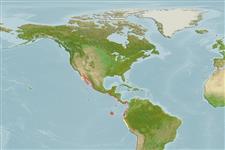Environment: milieu / climate zone / depth range / distribution range
Écologie
marin démersal; non migrateur; profondeur 1 - 50 m (Ref. 89707). Tropical; 32°N - 13°S, 115°W - 76°W (Ref. 5222)
Eastern Pacific: northern Gulf of California to Peru, including the Galapagos Islands.
Taille / Poids / Âge
Maturity: Lm ? range ? - ? cm
Max length : 30.0 cm TL mâle / non sexé; (Ref. 5222); common length : 18.0 cm TL mâle / non sexé; (Ref. 55763)
Description synthétique
Clés d'identification | Morphologie | Morphométrie
Épines dorsales (Total) : 11; Rayons mous dorsaux (Total) : 17 - 19; Épines anales: 3; Rayons mous anaux: 9. Preopercle rounded, the posterior edge distinctly serrate, with a large spine (usually covered with skin) projecting downward and forward at the angle. Color in life: head and body marbled reddish brown, with obscure bars and small dark and pale spots all over the head, body and median fins. Pectoral fins with 7 or 8 irregular transverse series of small dark spots (Ref. 5222); further characterized by having body depth less than or equal to head length, depth contained 2.3-2.8 times in standard length; caudal peduncle depth 11-12% of SL; eye diameter subequal to snout length, contained 4.1-5.5 times in HL; color in market: similar to color in life but color may fade to a buff, reticulations on pectoral fins usually remain (Ref. 89707).
A shallow water, cryptically colored, secretive species that inhabits seagrass areas. Also found in rocky reefs in depths of 1-50 m (Ref. 89707). Sedentary during the day, hiding in crevices or lying among seaweed, and rely on their effective camouflage to escape detection. Sometimes partly covering itself with sand. Nocturnal predators feeding mainly on benthic crustaceans.
Life cycle and mating behavior
Maturities | Reproduction | Spawnings | Egg(s) | Fecundities | Larves
Heemstra, P.C. and J.E. Randall, 1993. FAO Species Catalogue. Vol. 16. Groupers of the world (family Serranidae, subfamily Epinephelinae). An annotated and illustrated catalogue of the grouper, rockcod, hind, coral grouper and lyretail species known to date. Rome: FAO. FAO Fish. Synop. 125(16):382 p. (Ref. 5222)
Statut dans la liste rouge de l'IUCN (Ref. 130435)
Menace pour l'homme
Harmless
Utilisations par l'homme
Pêcheries: sans intérêt
Outils
Articles particuliers
Télécharger en XML
Sources Internet
Estimates based on models
Preferred temperature (Ref.
123201): 20.6 - 28.4, mean 25.9 °C (based on 66 cells).
Phylogenetic diversity index (Ref.
82804): PD
50 = 0.6250 [Uniqueness, from 0.5 = low to 2.0 = high].
Bayesian length-weight: a=0.01148 (0.00558 - 0.02364), b=3.04 (2.88 - 3.20), in cm total length, based on LWR estimates for this (Sub)family-body shape (Ref.
93245).
Niveau trophique (Ref.
69278): 3.5 ±0.50 se; based on food items.
Résilience (Ref.
120179): Haut, temps minimum de doublement de population inférieur à 15 mois (Assuming Fec > 10,000).
Fishing Vulnerability (Ref.
59153): Low vulnerability (20 of 100).
Nutrients (Ref.
124155): Calcium = 163 [65, 301] mg/100g; Iron = 1.07 [0.59, 1.98] mg/100g; Protein = 17.6 [15.8, 19.3] %; Omega3 = 0.244 [0.144, 0.415] g/100g; Selenium = 46.8 [26.8, 90.0] μg/100g; VitaminA = 28.4 [10.4, 87.7] μg/100g; Zinc = 1.26 [0.91, 1.83] mg/100g (wet weight);
